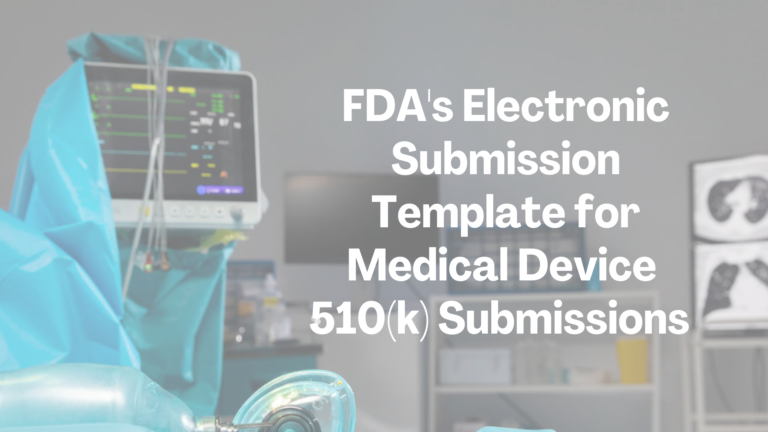FDA's Electronic Submission Template for Medical Device 510(k) Submissions
The Food and Drug Administration (FDA) is taking a significant step forward in streamlining the process for submitting premarket notification (510(k)) submissions for medical devices. This guidance document is designed to introduce submitters to the current resources and content developed by the FDA to support electronic submissions of 510(k) applications to the Center for Devices and Radiological Health (CDRH) and the Center for Biologics Evaluation and Research (CBER).

The ultimate goal is to enhance the consistency and efficiency of the submission and review process for medical device applications.
The FDA’s commitment to electronic submissions is driven by legal mandates, specifically Section 745A(b) of the Federal Food, Drug, and Cosmetic Act (FD&C Act), as amended by the FDA Reauthorization Act of 2017 (FDARA). This section empowers the FDA to specify the requirements for electronic submissions, set timetables, and establish criteria for waivers and exemptions.
To fulfill this mandate, the FDA issued the “Providing Regulatory Submissions for Medical Devices in Electronic Format” guidance document, commonly referred to as the “745A(b) device parent guidance.” This guidance laid the foundation for the development of electronic submission templates, including the one for 510(k) submissions discussed in this document.
Electronic Submission Templates
Electronic submission templates are tools designed to assist industry professionals in preparing, submitting, and reviewing regulatory submissions for medical devices in electronic format. The templates aim to improve submission consistency and enhance the efficiency of the review process.
This guidance document specifically focuses on the technical standards and requirements associated with the electronic submission template for 510(k) submissions. While it does not delve into the detailed user interface of the template, it establishes the necessary electronic format and standards to meet the FD&C Act’s Section 745(A)(b)(3) requirements. The FDA plans to update the template as policies evolve, ensuring it remains up-to-date and aligned with regulatory changes.
Significant Terminology
To ensure clarity, the guidance document defines several significant terms, including:
- eCopy: An electronic duplicate of a previously required paper submission.
- eSubmitter: A free FDA software program that includes electronic submission templates.
- Electronic Submission (eSubmission): The submission package created by an electronic submission template.
- eSTAR (Electronic Submission Template And Resource): A structured dynamic PDF template used for preparing 510(k) submissions.
- Electronic submission template: A tool that guides industry professionals through submission preparation.
- Structured data: Information captured within the electronic submission template.
- Unstructured data: Data submitted as attachments to the template.
Current Electronic Submission Template Structure, Format, and Use
The FDA’s electronic submission template for 510(k) submissions, known as eSTAR, plays a pivotal role in facilitating the transition to electronic submissions. eSTAR offers a structured framework that guides users through the preparation of a complete 510(k) submission. It boasts automation features, integrates various resources, and aligns with FDA reviewers’ internal templates.
The template captures both structured and unstructured data, ensuring that submissions closely follow the “SMART” 510(k) review memo template used by CDRH reviewers. Submissions prepared using eSTAR are less likely to undergo a “refuse to accept” (RTA) process, as the CDRH Portal automatically verifies their completeness.
Structure of the Current 510(k) Electronic Submission Template
The eSTAR template consists of various sections, each serving a specific purpose in the 510(k) submission process. These sections include:
- Submission Type: Identification of key information for initial processing and review.
- Cover Letter / Letters of Reference: Attachments and references to other submissions.
- Applicant Information: Details about the applicant and correspondent, if applicable.
- Pre-Submission Correspondence & Previous Regulator Interaction: Information on prior submissions related to the current one.
- Consensus Standards: Identification of voluntary consensus standards used.
- Device Description: Comprehensive information about the device, including materials, design, and conditions of use.
- Proposed Indications for Use (Form FDA 3881): Identification of proposed device indications.
- Classification: Identification of the most appropriate classification regulation.
- Predicates and Substantial Equivalence: Comparison of the subject device with predicate devices.
- Design/Special Controls, Risks to Health, and Mitigation Measures: Applicable to Special 510(k) submissions.
- Labeling: Submission of proposed labeling in detail.
- Reprocessing: Information related to reprocessing validation and labeling.
- Sterility: Information on sterility and validation methods.
- Shelf Life: Methods used to establish device performance throughout the proposed shelf life.
- Biocompatibility: Assessment of patient-contacting materials.
- Software/Firmware: Submission of relevant software documentation.
- Cybersecurity/Interoperability: Information on cybersecurity assessment.
- Electromagnetic Compatibility (EMC), Electrical, Mechanical, Wireless and Thermal Safety: Testing information or justification.
- Performance Testing: Non-clinical and clinical test reports.
- References: Inclusion of literature references, if applicable.
- Administrative Documentation: Additional administrative forms.
- Amendment/Additional Information (AI) Response: Responses to Additional Information requests.
Electronic Submission Template Waivers, Exemptions, and Timing
All 510(k) submissions, including Traditional, Special, and Abbreviated 510(k)s, must be submitted electronically unless specific exemptions or waivers apply. Exemptions cover certain types of submissions, such as interactive review responses, amendments, appeals, and more. However, FDA does not currently grant waivers for 510(k) electronic submission requirements.
When Electronic Submissions Will Be Required
To ensure a smooth transition, the FDA has set October 1, 2023, as the date when the 510(k) electronic submission requirements will take full effect. This date includes a minimum one-year transition period, during which eSTARs can be voluntarily used for 510(k) submissions. After this transition period, all 510(k) submissions must be provided electronically through FDA’s electronic portal or the Electronic Submission Gateway for CBER.
Conclusion
The FDA’s Electronic Submission Template for Medical Device 510(k) Submissions represents a significant leap towards modernizing the submission process for medical devices. By offering a structured and comprehensive framework, this template aims to enhance consistency, quality, and efficiency in the premarket review process. Submitters should be aware of the upcoming requirements and consider adopting eSTAR for their 510(k) submissions as part of this transformative change in the medical device regulatory landscape. Consult RABT for comprehensive support on the Submissions support.

